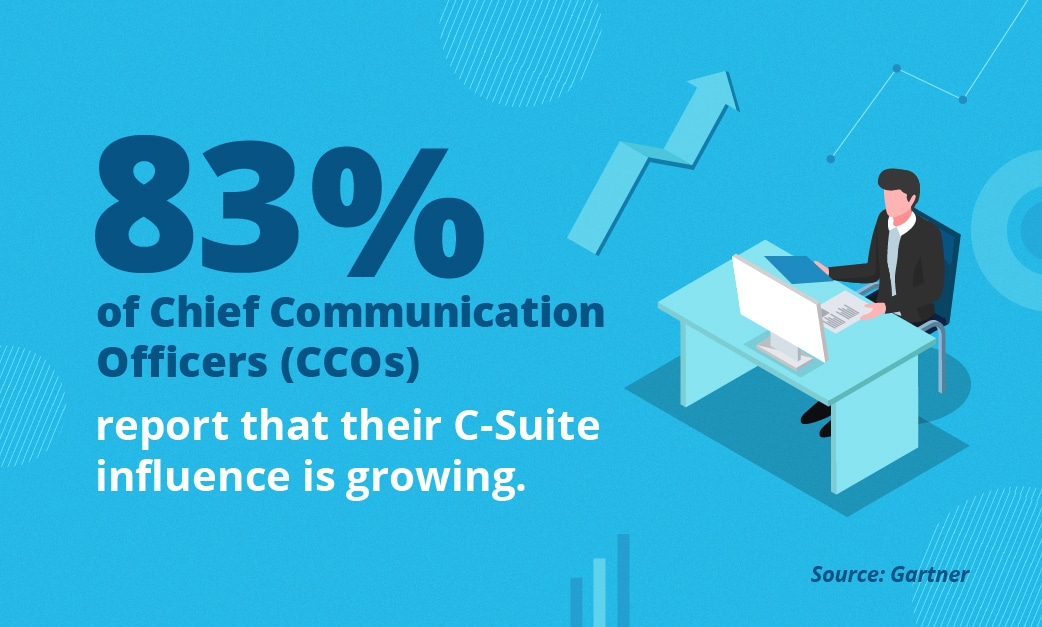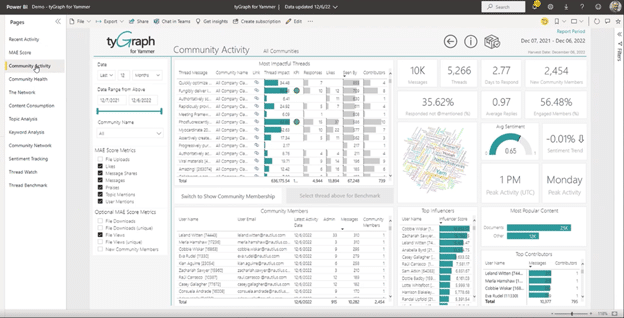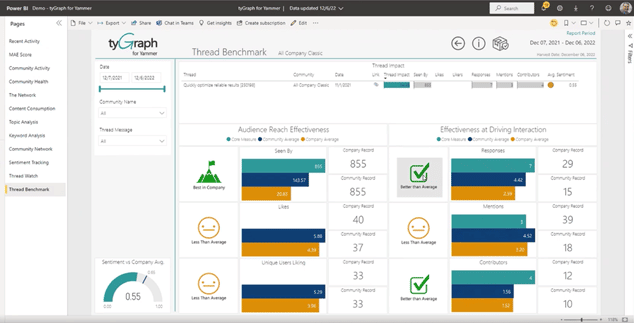From Intuition to Impact: How Analytics Can Enhance Your Internal Communications

As social media, online news, and employees’ own voices were amplified by new platforms and technologies over the past several years, the role of corporate communications began to evolve from traditional (internal memos, press relations, and the like) to agile and multidisciplinary—a critical part of the corporate ecosystem. Then, a string of global socioeconomic and healthcare events left an indelible impact on the communications role, accelerating its evolution once again.
More than ever, executives must be prepared to respond to issues quickly, highlight their corporate values, and demonstrate transparency to both internal and external stakeholders. The consequences of fumbling this messaging goes beyond a simple faux pas, risking significant financial and reputational damage.
Today’s communications leaders find themselves in a position of expanded power, often serving as strategic advisors to chief executives. In fact, a 2022 Gartner survey found that 83 percent of chief communication officers (CCOs) reported that their C-Suite influence is growing. “Companies are placing a larger emphasis on stakeholder communications and cross-functional collaboration,” said Jennifer Sigler, director analyst in the Gartner Marketing & Communications practice. “Given communicators’ unique talents in stakeholder relationship management, it would make sense that CCOs and their teams are being asked to play a central role in efforts to improve collaboration and other employee-related outcomes across the organization.”
 With 98 percent of CEOs anticipating a U.S. recession, pressure on “support costs” like marketing and communications will rise. Communications leaders will undoubtedly be expected to show ROI as part of their quest to maintain (or grow) resources. Proving the value of corporate communications hinges on proving value through measurement. While tools for external communications now offer rich insights, analytics for internal communications continue to lag behind. According to a 2022 Edelman survey, “Qualitatively, communicators see how good content affects consumer behavior and business performance and compels stakeholders to action. But the quantification and correlation of impacts remain elusive and time-consuming.”
With 98 percent of CEOs anticipating a U.S. recession, pressure on “support costs” like marketing and communications will rise. Communications leaders will undoubtedly be expected to show ROI as part of their quest to maintain (or grow) resources. Proving the value of corporate communications hinges on proving value through measurement. While tools for external communications now offer rich insights, analytics for internal communications continue to lag behind. According to a 2022 Edelman survey, “Qualitatively, communicators see how good content affects consumer behavior and business performance and compels stakeholders to action. But the quantification and correlation of impacts remain elusive and time-consuming.”
So how can communications teams reinforce their value?
Proving Value: What Does Success Look Like?
To better understand the challenges associated with measuring results in the Communications function, we spoke to AvePoint’s own Chris Musico, Senior Director of Communications.
Q: Hey, Chris. Thanks for giving us a few minutes of your time!
A: My pleasure. Happy to be here.
Q: Let’s talk about communications. What falls under the category of corporate communications?
A: As a corporate function, “Communications” typically encompasses both internal and external messaging. Here at AvePoint, for example, internal communications include everything from executive messages sent by our c-suite to organization-wide events like Town Halls. There’s also a consultative aspect to the job, where we advise leaders on best practices and work with them to make sure their messages are being conveyed clearly and effectively.
Externally, we manage social media, media relations, customer case studies, content marketing, and investor communications, in addition to supporting special projects, including Talent Brand and Corporate Branding.
Q: When you’re trying to measure how a message or social post will land, what kind of tools do you have at your disposal?
A: Externally, there are plenty. We have tools that look across the entire digital world, analyze the different ways AvePoint is mentioned, and figure out whether the sentiment is positive, neutral, or negative. Additionally, we can also look at our content’s “reach,” which means the number of impressions, how often it’s showing up in people’s feeds, and how users are engaging with our content. Essentially, we’re able to measure how far our message is going and how it’s received.
Q: Do any of those help you understand internal messaging?
A: No – the tools we use today to gain analytics on our external communications efforts don’t account for communications inside our own walls.
Q: Chris, what would be a good outcome for internal communication?
A: Ideally, we want to know that the message is making it to the right audience, how it’s being received, whether the audience understands it, and if they’re able to take any necessary actions prompted by the message.
The easiest outcome we can measure is getting the message to the right audience. For example, if there’s a communication we want to get to all AvePoint colleagues, we can assure it reaches them if we send an email to our “All Company” list. The real value comes in the other outcomes we look to achieve, and with the tools at internal communicators’ disposal today, it’s extremely difficult to measure employees’ understanding and engagement at scale.
Q: If you had a way to fill in those blanks, what would you do with that information?
A: That would be gold. The only way to measure those outcomes right now is by collecting ad hoc feedback – going to team and department leaders and asking them about any feedback they heard from their people on the message – which can be inherently biased and doesn’t scale for our global organization. In today’s age of global, hybrid work – you can’t walk down the hallway anymore and talk to everyone to see how a message landed.
If we could find out where employees are interacting with a message (email, Yammer, intranet, etc.), that would be great. Even better, if we could understand how the message landed – if it was the right message and whether there’s confusion and we should send a follow-up to clarify, that would be huge. We’d be able to make data-driven decisions about how to respond and how to deliver messages going forward – in the same way we handle our external communications today.
Q: Any other thoughts?
A: Our ultimate goal isn’t quantity; it’s quality. While it’s important to have the right level of activity, having better insight into the reach, engagement, and sentiment of those internal communications activities would help us better demonstrate the value of internal communications and garner support for additional activities and investment going forward.
A leader in the employee experience and workplace analytics space, tyGraph, now an AvePoint company, empowers Communications teams to measure their efforts quantitatively. With purpose-built solutions for commonly used internal comms channels such as Microsoft Teams, SharePoint, and Yammer, tyGraph’s analytics can help verify that internal communications are actually read (not just received), gauge employees’ sentiment, and determine which channels are most effective.
Today’s Communications professionals know that most messages are not static—especially in Microsoft 365. They have a lifecycle that may start in email, drive users to Yammer, and then end up in a Teams chat. While Microsoft’s native tools measure workload by workload, tyGraph tracks activities and engagement across these different Microsoft 365 channels so that you can get a 360-degree view of your efforts.
-
Measure Your Engagement
Take this Metadata Engagement dashboard, for example. Beyond simply counting the number of viewers, tyGraph evaluates verified unique readers, time spent on page, percentage of page scrolled, and more. With simple date sliders and customizable goals, you can easily view trends in your content.
While SharePoint’s native analytics measure clicks, tyGraph goes deeper, looking at how much of the page has been read, how long an employee spent engaging with your content, and more. Google Analytics users will likely be familiar with most of the metrics displayed on this dashboard, including bounce and exit rates.
These insights aren’t just nice to have, they’re actionable. For example, if the data shows a high volume of searches for a certain asset, you might want to feature that piece of content more prominently in your intranet to make it more readily accessible.
-
Get to Know Your Community
tyGraph’s Community Activity dashboard helps you keep an eye on your most impactful threads, scoring their overall impact and measuring responses, likes, contributors, and viewers. If lots of employees read a Yammer post but no one “likes” or responds, that’s something to pay attention to.

Next, take it a step further and identify commonly used terms, peak activity times, and even top influencers within your company. Imagine if you could leverage a top influencer to amplify your message, post it at the time of day when people are most active, and then follow the thread to see how people respond. Sounds like a better way of doing things, right?
-
Benchmark for Better Best Practices
While Communications professionals have historically had to rely on industry best practices (and their own past experiences) to advise leaders on an internal comms strategy, it’s largely been a subjective process. Now, tyGraph’s rich analytics empower Communications teams to benchmark the success of past activities and validate future strategies based on quantitative data. “Instead of saying, ‘Hey, Mr. Executive, people thought your last post was great,’ we can actually share empirical evidence to support that statement,” says Chris.

tyGraph’s Thread Benchmark dashboard analyzes how a particular thread performed as compared to others, drilling down to Audience Reach Effectiveness and Effectiveness at Driving Interaction. With simple visualizations that rate a specific thread as better or worse than average, Communications teams can get a quick snapshot of the thread’s performance.
Visualize and Validate
The combined impact of new technologies and the historic events of the past few years have elevated the role of corporate communications to mission-critical. CCOs and communications leaders now find themselves in an era of unprecedented influence, advising executives on how to shape the business narrative, respond to crises, and define an organization’s purpose.
While the communications role has evolved quickly, technology hasn’t quite caught up. Externally, there is a crowded market of tools designed to measure an organization’s reach and engagement. But internally, most communications teams still find themselves struggling to measure their efforts and instead rely on “spray and pray” tactics or subjective feedback.
Communications leaders are feeling the pressure to demonstrate their value in black-and-white—that’s where tyGraph comes in. With rich analytics and visualizations, tyGraph captures a 360-degree view of your Microsoft Teams, SharePoint, and Yammer data to validate the reach, engagement, and response to your corporate messaging. Armed with this empirical evidence, CCOs can not only benchmark and optimize their efforts, but they can also justify their enhanced role by proving their team’s value across the organization.
Find out how you can turn insights into impact with tyGraph.
Stay up to date on the latest articles about what’s new in technology, SaaS Management & Governance, SaaS Backup and Data Management. Subscribe to our blog now.
Gabrielle is a Product Marketing Manager at AvePoint, bringing nearly 15 years of experience overseeing lead gen, content marketing, branding, and business development initiatives for a variety of industries, including SaaS technology solutions, healthcare, insurance (insurtech), cyber security, legal, consumer goods, advisory, and public accounting.






